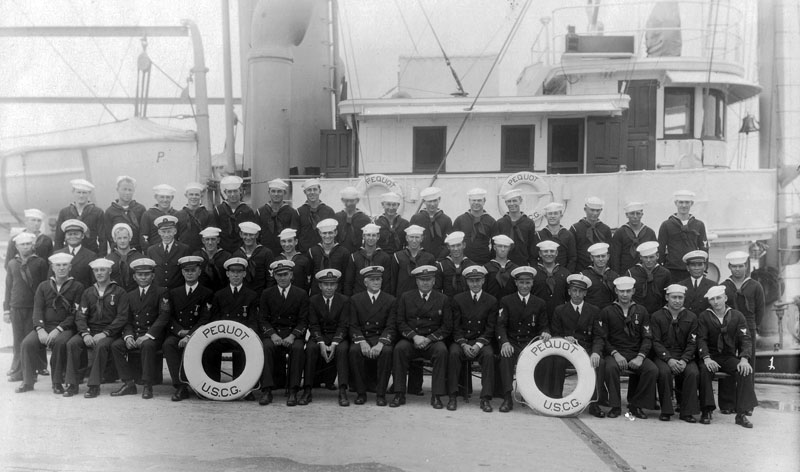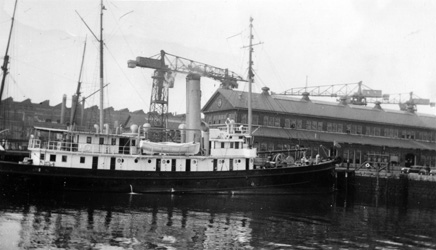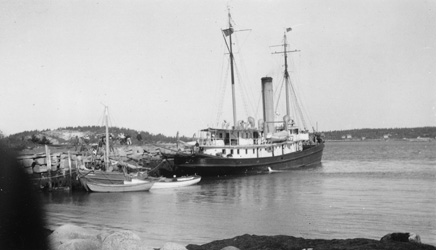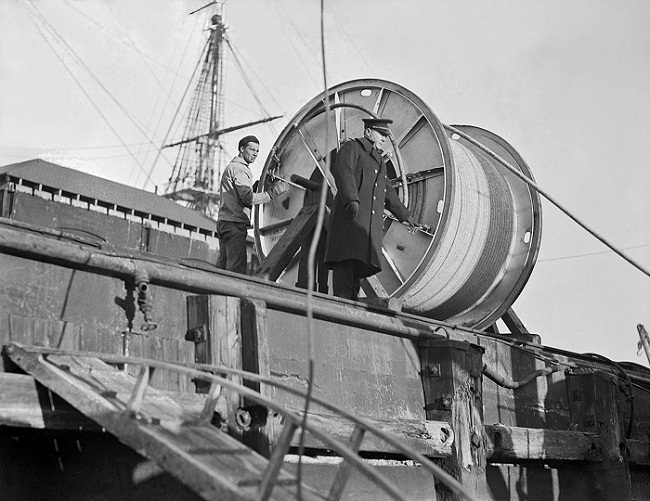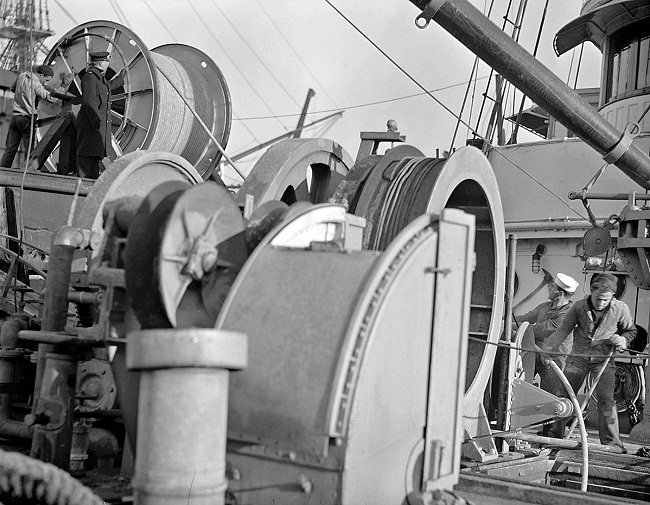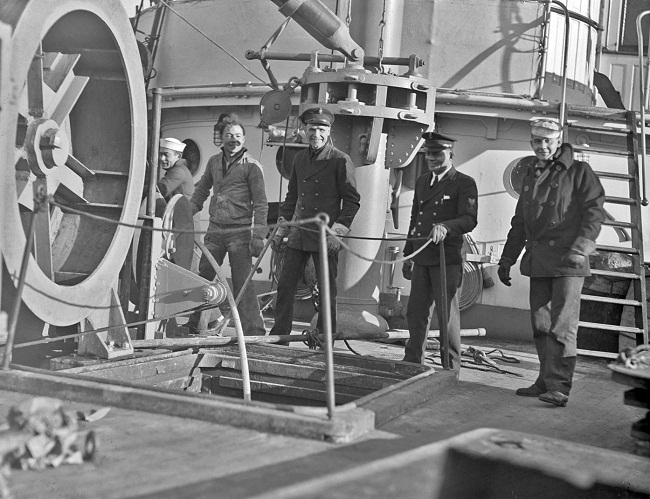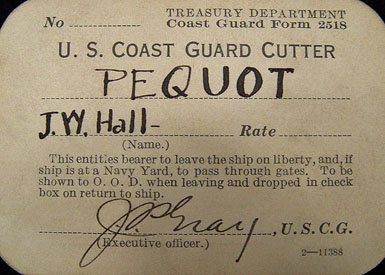USCG CABLE SHIP PEQUOT - UNITED STATES
HARBOR DEFENCES
USCG Pequot Between the Wars
These rare photos below show the Pequot before the onset of World War II.
During this period the ship installed and maintained telephone, telegraph, and
other communication cables along the entire Eastern seaboard of the United
States. These underwater cables linked lifeboat stations and coastal navigation
aids that received poor service from commercial telephone and telegraph
companies. Note the absence of the two 20mm guns on the ship's fantail which
were installed after the Japanese attack on Pearl Harbor and the beginning of
U-boat attacks.
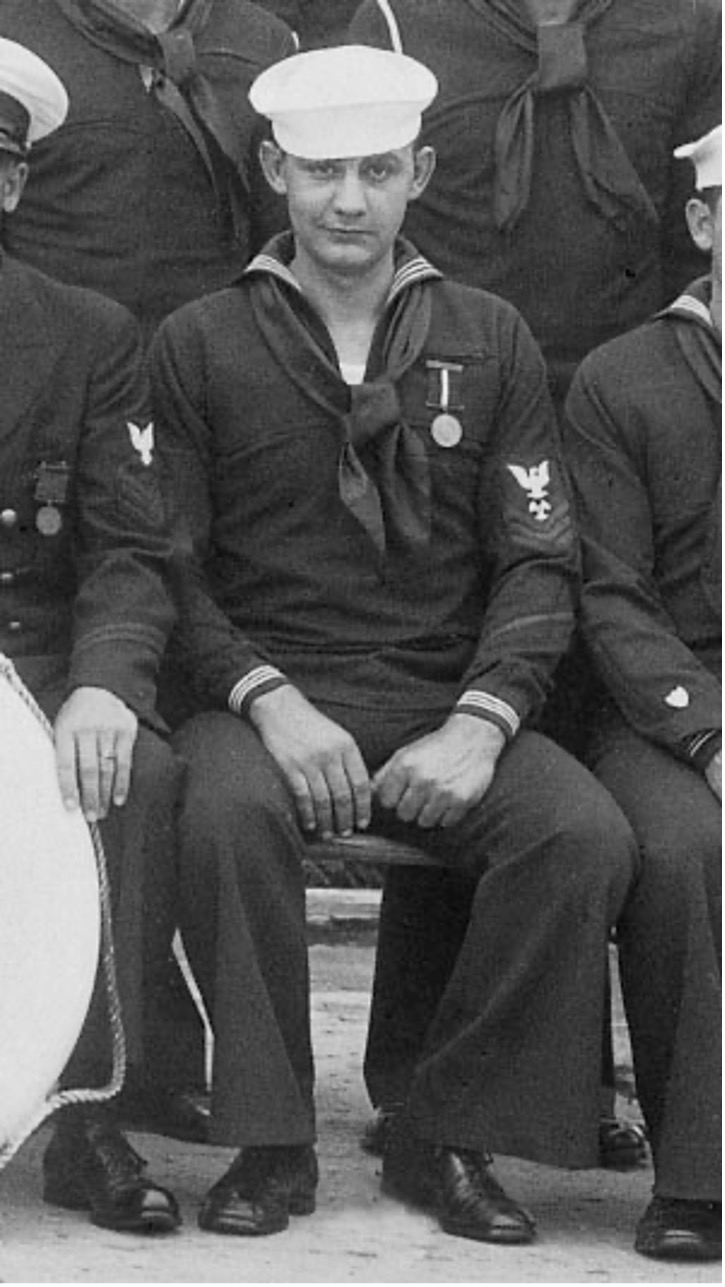 |
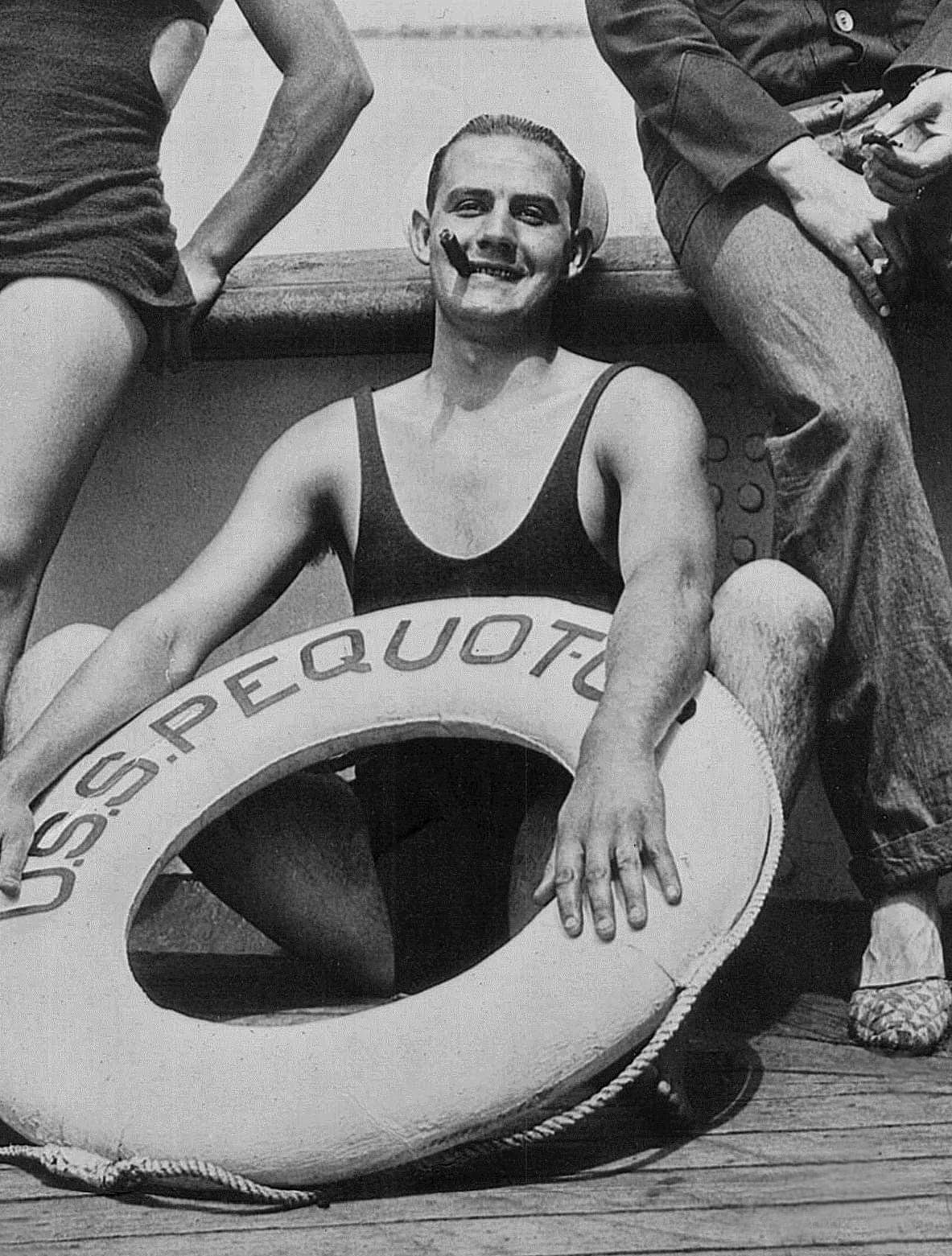 |
| Coast Guard Motor Machinist Stephan Vozar Jr. who we see seated third from the right in that 1930s crew photo and posing for fun with one of Pequot’s life preservers. After serving aboard Pequot in the early 1930s he shipped aboard the Coast Guard Cutter and Ice Breaker Escanaba (WPG-77). As fate would have it, he was on dry land laid up with a back injury in the Boston Naval Hospital when Escanaba was sunk by a sea mine or torpedo on June 13th 1943. Pequot radio operator John McCormack was thrown out of his bunk by the force of that explosion aboard the cutter Storis (WAGL-38) that was following directly behind Escanaba. |
|
 |
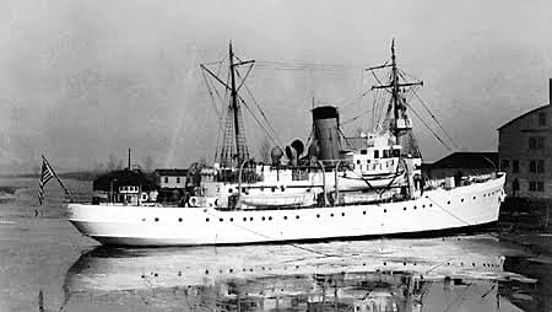 |
(Historical Collections of the Great Lakes and gCaptian.com) |
|
Below: The
following front page newspaper article from the March 4, 1931 St.
Petersburg, Florida
Evening Independent provides some insight
into the mission of the Pequot before World War II.

of marine borer, the teredo worm. These tiny creatures found their way through the cable armor
and dined on the jute insulation, exposing the conductor and causing earth faults.
A Look at the Pequot in the 1920s
The Pequot research project was contacted by collector Derrick Alderman of Old Paper Studios who picked up a vintage photo album at auction in 2018. In the album were a number of photos of the Pequot and her crew during the 1920s after the ship was converted in 1922 to a Coast Guard cable layer and repair ship from the Army Mine Planter Samuel M. Mills. We do not know who any of these men were, or who the album belonged to, but these photos, donated to our research project by Derrick, provide a rare glimpse into life aboard the Pequot between the wars and how the ship was initially fitted out for cable work. US Coast Guard Atlantic Area Historian William H. Thiesen also helped us with details seen in these photos, particularly the Pequot Medicine Ball team. Thanks Derrick and Bill!
 |
The Pequot shortly after its 1922 conversion from an Army Mine Planter to a US Coast Guard cable laying and cable repair ship. This image is consistent with the 1927 Coast Guard photo of Pequot showing the large cable spool on the port side of the forward deck but before the bow mounted cable pully or "sheave" was installed along with the large motorized cable winch installed starboard of the main boom as seen in a 1933 photo of the ship. |
 |
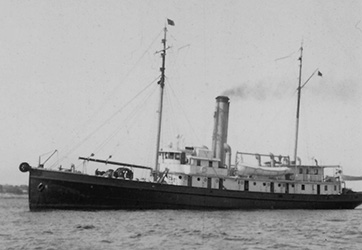 |
1927 |
1933 |
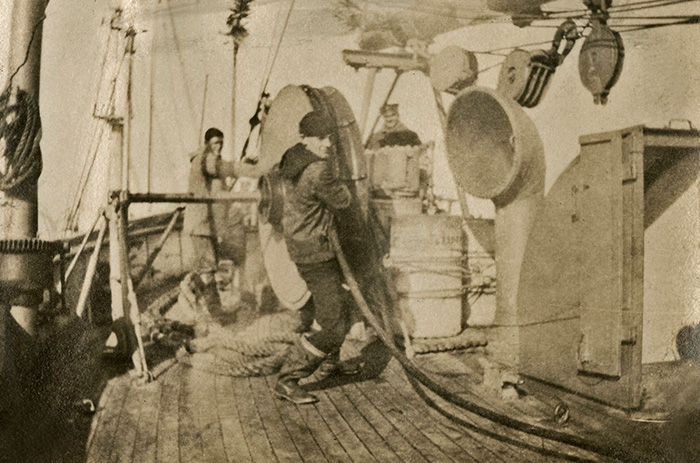 |
Sailors working with thick undersea cable on Pequot's forward deck using a large cable spool recently installed on the port side. A Petty Officer is seen up by the bow overseeing the operation. In front of the companionway which leads down to the forward crew quarters we see a large air funnel that was later changed to an air in-take without a scoop. Probably because it was freezing those guys out down there. WWII era Gunner's Mate Roger Calamaio said that the crew bunk he was first assigned to was directly under an outside air vent and that everyone called it "Pneumonia Corner," and it was reserved for new guys who'd just shipped on. |
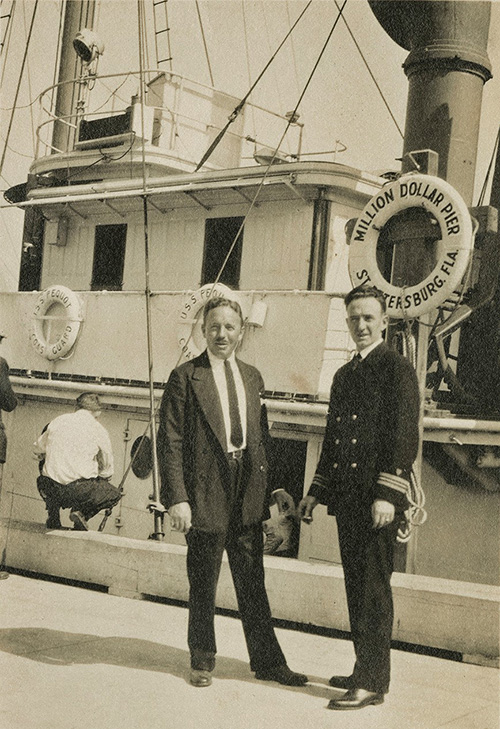 |
The Pequot docked at St. Petersburg Florida at the "Million Dollar Pier" circa 1926-30. The officer on the right, perhaps with a local dignitary, is in a Coast Guard dress uniform of the period. The Pequot operated around the Gulf Coast and the Southeastern states during the 1920s running coastal communications cable and servicing lifesaving stations. St Petersburg was a common port of call as seen by the 1931 newspaper story on this page. |
After the former Municipal Pier was damaged by the Tampa Bay Hurricane of 1921, St. Petersburg appropriated a $1 million bond for a new pier which was dedicated on Thanksgiving Day 1926. It featured a Mediterranean-style casino with observation deck, open-air ballroom, and an interior atrium for community events. http://www.newstpetepier.com/history.php
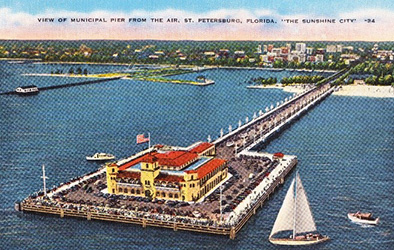 |
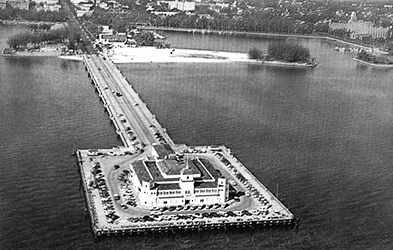 |
(Vintage Postcard) |
(State Library & Archives of Florida) |
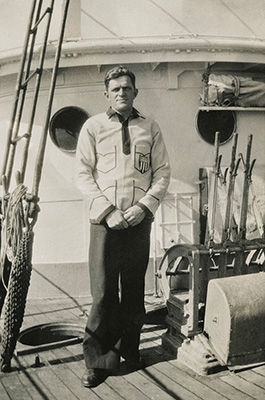 |
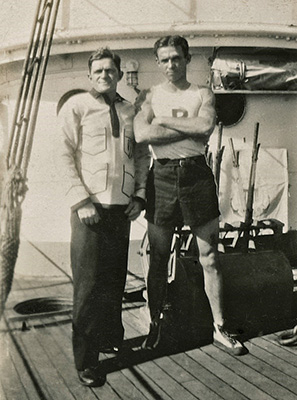 |
It appears that Pequot had a Medicine Ball team as we can see from this sequence of photos where sailors are wearing sports tops with a large letter "P", sports shorts, and athletic shoes. We speculate that their coach was the spiffy fellow dressed in uniform bell bottoms and white sweater with piping and a large Coast Guard shield patch that is embroidered "USS PEQUOT." On the deck we can see an uncovered "Watertight Scuttle" which provided ventilation to the deck below yet could be sealed up tight to stop rain or seawater. The "Eye Bolt for Sheet Block" shown on the construction drawings is also seen on the deck next to the rat line ladder going up the main mast. On the right we can see the control levers for the anchor chains, capstans and boom arms. |
|
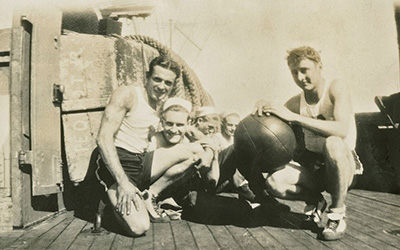 |
 |
These sailors are kneeling down for a photo next to the companionway door that leads down to the forward crew quarters. Seen behind them, laying on its side, is a small boat that has PEQUOT JR written on the stern in white. The ball being held is a Medicine Ball used in the competitive "Bull-in-the-Ring" game played by teams from Navy ships and, beginning in 1928, in "Hooverball" competition, which was a game started by then President Herbert Hoover's physician to keep the president fit after the President saw a "Bull-in-the-Ring" game aboard the Battleship Utah. In the late 1920s, to the end of Hoover's term in 1933, Hooverball was quite the rage and apparently Pequot's crew was part of the action. The President played with his cabinet members every morning at 7am. They became known as the "Medicine Ball Cabinet." |
|
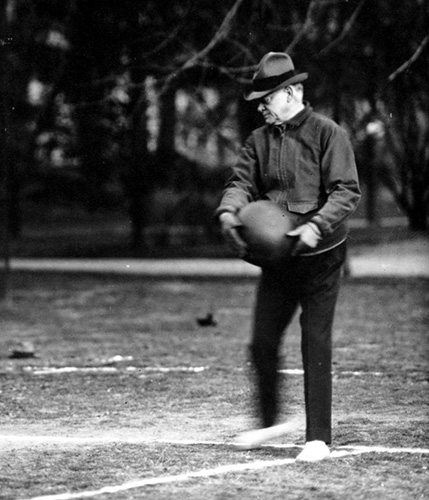 |
(Herbert Hoover Presidential Library and Museum) |
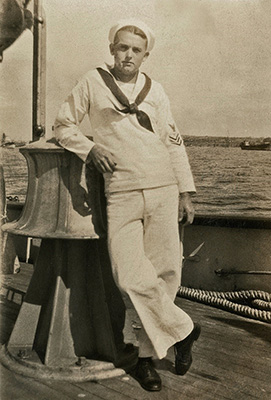 |
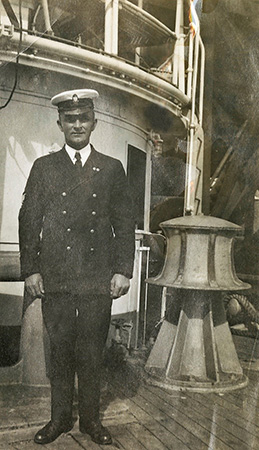 |
A Petty Officer and a sailor in his dress white uniform both posed for a photo by the large Electric Capstan on the Pequot's aft deck. Behind the officer we can see the large rear stanchion which would be used to tie on a tow cable if Pequot ever had to tow another ship. We can even see the "Hose Valve" behind him down on the deck which is shown on the construction drawings. |
|
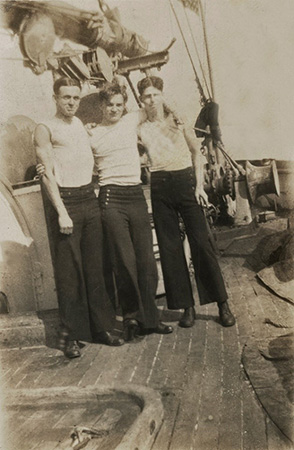 |
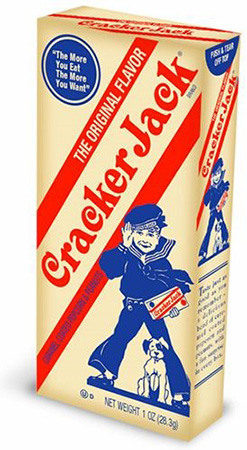 |
These three sailors in white t-shirts are standing on the Pequot's forward deck next to the crew companionway hatch with the forward cable, boom and anchor gear behind them. They are wearing the classic US Navy and Coast Guard dark blue bell bottom pants. These pants which became known as "Crackerjacks" for the sailor shown on the front of the Crackerjack snack box, are famous for the myth that the 13 buttons on them represent the 13 original colonies, a belief that has persisted among US sailors for more than 150 years. The large main boom and its support are seen directly above them with a maze of block and tackle rigging. In the foreground we see one of the two main cargo hatches. |
|
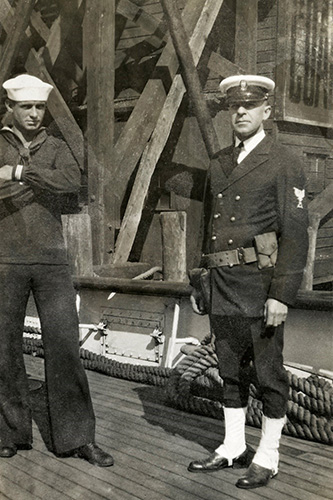 |
Here we see a Pequot Petty officer sporting white dress spats in his full uniform and hat. He was most likely on duty as the armed Officer of the Day when the ship was in port. It could be a liberty day as the sailor next to him is looking quite sharp in his dress blues. The hatch in the gunwale behind them may be one of the "Freeing Ports" shown on the construction drawings. We believe it could be dropped open in heavy seas so that water that breached the bow could run off the deck or used when pulling rigging or cable aboard. |
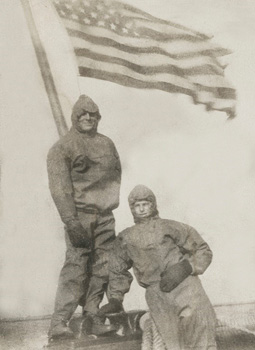 |
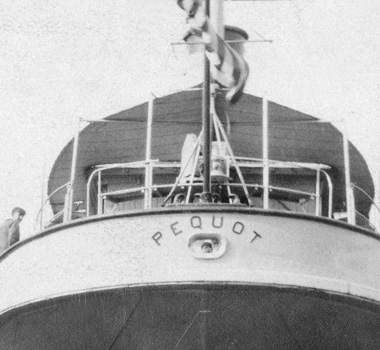 |
A fun look at 1920s Coast Guard foul weather gear as these two sailors stand on Pequot's stern under Old Glory. They are on the large rear cleat used to tie Pequot to a dock when in port. It is located directly above the ship's "towing chock" which was built into the gunwale so thick towing cables could be fed to the large rear stanchions in case Pequot ever had to tow another vessel. |
|
Pequot Installs the Ambrose Channel Pilot Cable 1919-20
Ambrose Channel is the only shipping channel in and out of the vital commercial ports of New York City and New Jersey. Weather delays posed a major problem for shipping and could close the channel for days. Ships were forced to wait at the harbor's entrance, at great expense, for conditions to clear.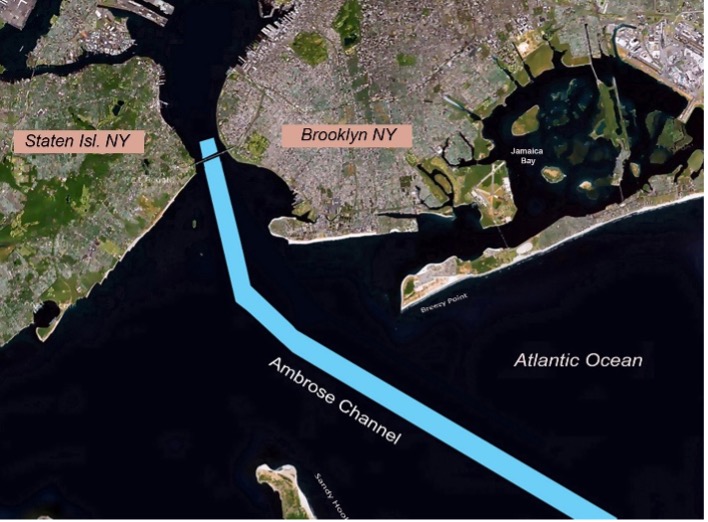 |
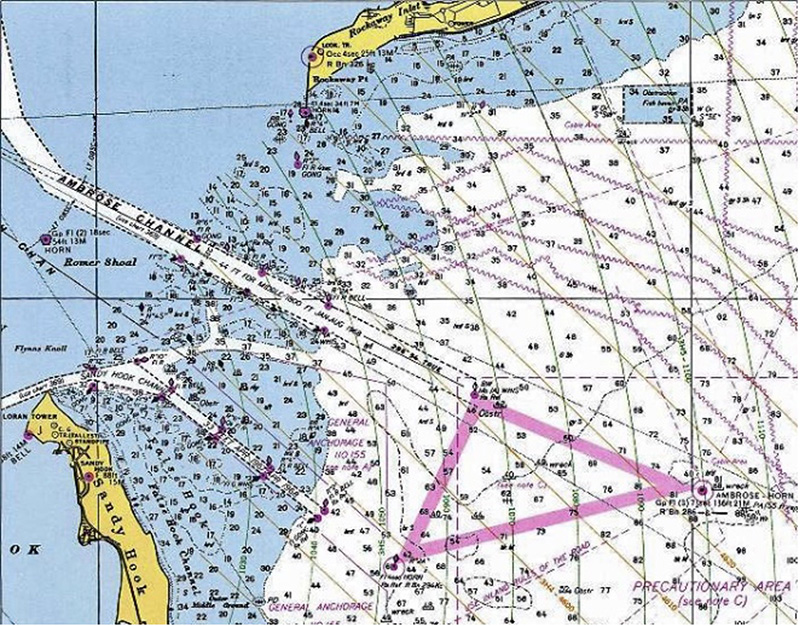 |
| To enable safe navigation in foul weather the "Ambrose Channel Pilot Cable," also called the "Ambrose Channel Leader Cable" was laid at the entrance to the Port of New York. This new technology used an audio tone to guide ships in and out of port at times of low visibility. This 16-mile cable was laid by the Pequot during 1919 and 1920. | |
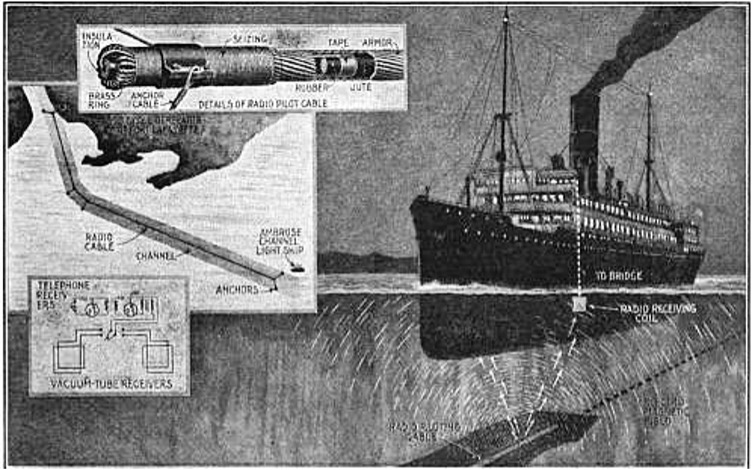 |
| Records indicate Pequot arrived in New York on July 31, 1920 where the pilot cable was loaded aboard at the Boston Navy Yard. Since the Ambrose Channel was already crossed by three telegraph cables, owned by Western Union, the Army, and the police, they all had to be raised to the surface so the pilot cable could be laid down underneath them by the Pequot. The installation of the cable was completed on August 6, 1920 |
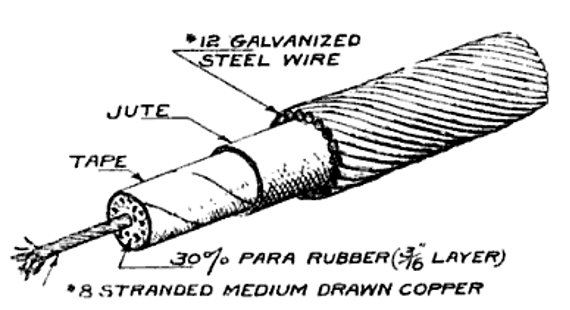 |
| The multilayered cable the Pequot laid down in the Ambrose channel was an armored cable with a single internal conductor that acted like a long radio antenna laid on the channel floor. After some trial and error, the whole thing worked so well the Washington Post called it "The greatest development in marine travel since the invention of the steam turbine" and the Los Angeles Times declared the technology to be "One of the greatest peacetime gifts that science has devised." |
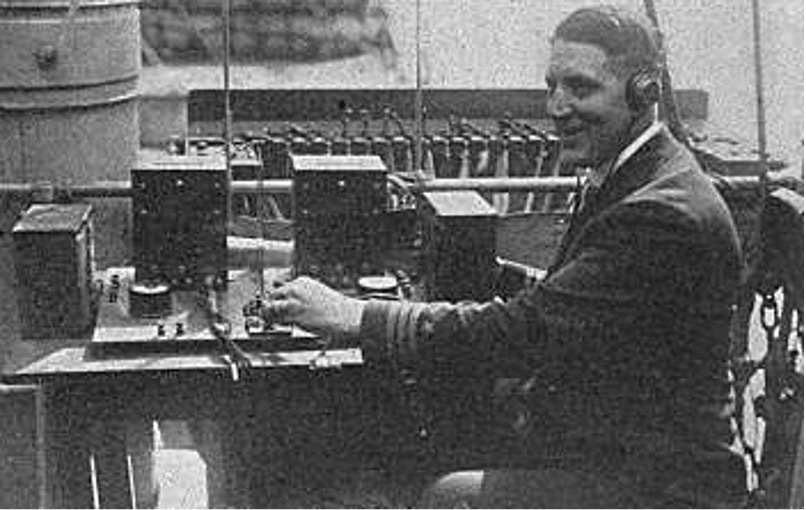 |
| Initial testing of the newly installed Ambrose pilot cable by Commander R. F. McConnell aboard the USS Semmes (DD-189) using an induction coil "Hanson Apparatus" receiving station. (Nautical Gazette 1920) |
To use this navigational aid, ships had to install a pair of induction coils hung on opposite sides of their hull that fed through an amplifier into a headset. For some initial "Proof of Concept" testing ship pilots were blindfolded and only navigated using the tones they heard.
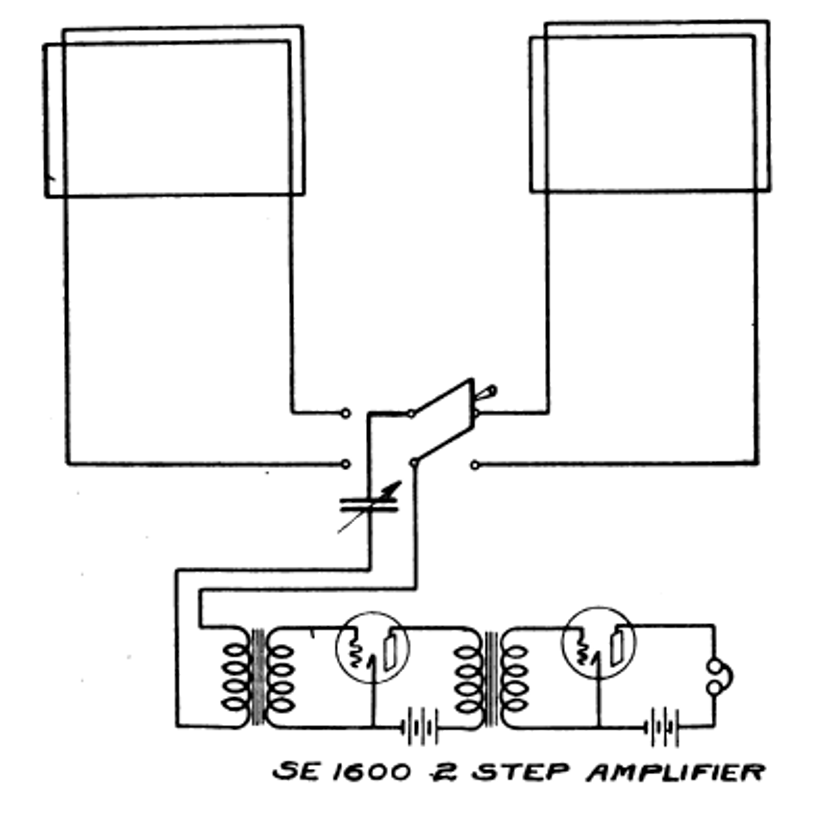 |
By switching between coils, the relative strength of the signal on each side could be compared. By monitoring those signals the ship could maintain a course parallel to the cable by maneuvering to keep the signal strength constant. |
The cable itself and its operation was paid for using public funds, but it was the responsibility of ship owners to outfit their vessels with receiving equipment. Despite the good PR and fanfare, the technology was short lived as not all ships wanted to spend the $1200 needed to install the receiving equipment, and by the end of the 1920s pilot cable systems became obsolete by the deployment of radio direction finding and the placement of low power radio beacons at strategic locations around harbors.
 |
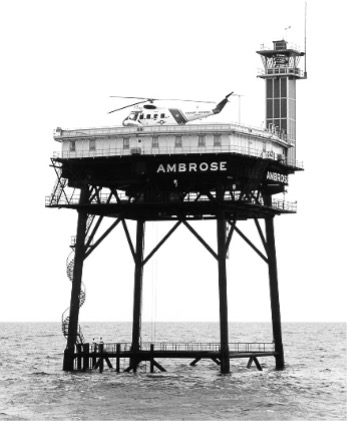 |
| The stationary Ambrose Light Ship and mid-channel Ambrose lighthouse tower were navigational aids also deployed after the Pilot Cable and before GPS technology (US Coast Guard) Those beacons analogous to electronic lighthouses can be "seen" in all weather and were quickly adopted for navigation in bad weather. Now ships safely find their way world-wide by satellite transmitted GPS technology. | |
 |
| To learn about the harbor defense of the Ambrose Channel during WWII see the Indicator Loop page: http://indicatorloops.com/usn_tilden.html |
LOADING THE PEQUOT WITH CABLE - 1930
In December of 1930 renowned Boston area photographer Leslie Jones documented the officers and crew of the Pequot loading cable at Constitution Wharf. These images have been archived under the title: "USS Pequot carrying 18 miles of submarine cable to be laid in southern waters." The mission the ship was preparing for here was most likely to provide one of many communication links between Coast Guard Life Saving Stations and Lighthouses. Between World War I and World War II the Pequot laid more than 585 miles of submarine cable.
| A Coast Guard officer oversees
the cable loading operation while a seaman manually turns the
large spool of communications cable up on the dock. The cable is
being played out off the spool to crewmen down on the fo'castle
deck who lower it by hand into the Pequot's forward hold where
other crew coil into place. In the background we can see one of
the masts of the USS Constitution rising above a warehouse roof. Click to Enlarge (Boston Public Library, Leslie Jones Collection) |
A technical challenge of the times was manufacturing
undersea cable that remained sealed and waterproof. The latex-like sap
of the Southeast Asian gutta percha tree was used for early underwater
cable insulation and waterproofing by Simplex and other manufacturers.
But after several decades of aggressive harvesting the supply of gutta percha trees simply started to run out.
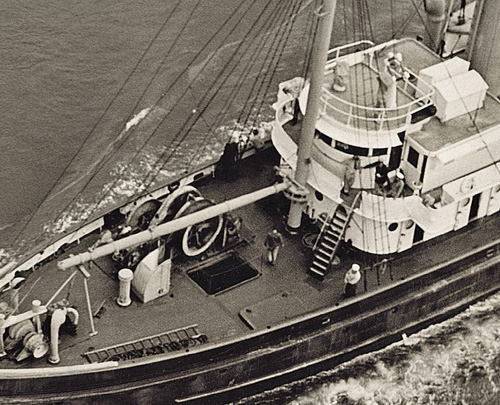 |
| This
1940s aerial view of the Pequot's fo'castle deck clearly shows the
ship's forward hold next to the large cable winch and the
companionway entrance to the forward crew quarters below deck
where cable was routinely loaded as shown in these 1930s photos.
We can now see that little changed on the fo'castle deck between
1930 and the early 1940s.
|
A special thanks to Jerry Butler for locating these Leslie Jones
images and to Bill Burns with the Atlantic Cable website for passing
along the technical and historic details of the Simplex Wire and Cable
Company.
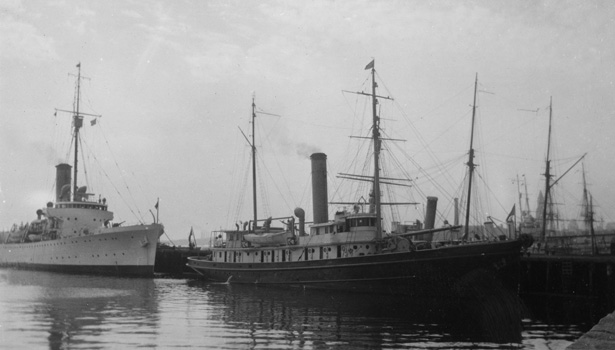 |
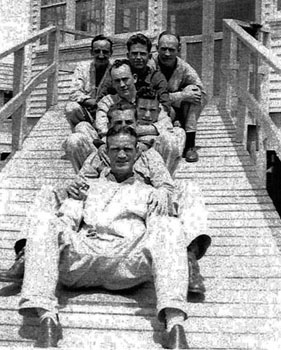 |
The Pequot tied up in Boston Harbor. Seeing the forest of masts and rigging behind the ship we realize that the Pequot was first in service during the maritime era when ships were still transitioning from sails to steam. The tower of Boston's Customs House and the masts of USS Constitution can be seen in the background. Berthed behind Pequot we see the 250 foot Coast Guard "Lake Class" cutter Itasca (Y-92). http://coastguard.dodlive.mil/2012/07/itasca-the-search-for-amelia-earhart/ Click the image above to see an enlargement. |
Gerald Joseph Murphy (see below) seated in the front of this group of sailors taken in the mid-1930s. His daughter believes this was taken while he was recovering from a service related injury which led to his 1938 Coast Guard discharge. (Geralyn Murphy Brousseau) |
| Gerald Joseph Murphy from Gloucester,
Massachusetts joined the Coast Guard in 1935 at the age of 25. According to his
discharge papers he spent time aboard the CGC Cayuga and then served on
the Pequot before WWII as a Seaman 1st Class under the command of Chief
Boatswain C. Jensen. After he was discharged on March 21st 1938 he served
in the Merchant Marine during WWII. His daughter Gerri writes that, "He always had wonderful stories and I could sit for hours listening to him tell about his travels around the world. He had one particularly funny story about a trip to south America where he got a monkey. During the war, he was on three different ships that were sunk, one in the waters near Iceland, where he nearly froze to death as he bobbed around for three days in that frigid water before being rescued by a Norwegian ship who heard their distress call." After the war he moved to Waterbury, Connecticut where he married, raised a family, and worked as a machinist at the Anchor Fastener Company. Gerald J. Murphy passed away on March 12th 1980. |
 |
|
The Pequot in Dry Dock - November 9th 1922.
Her twin screws were able to run forward or reverse independently. This made it possible to position the Pequot exactly where need to accurately place loop cables on the seafloor. Top speed was 12 knots with a maximum cruising radius of 1670 nautical miles. Details on the tricky business of spacing the loop cables can be found in the USN Harbor Defense Manual on Pages 53 &54. |
We believe this vintage
Liberty Pass for Pequot sailor "J.W. Hall" was issued well
before World War II. When compared to the 1940s shore passes
shown in our story of Storekeeper Bill Moore we see it is an older hand written version of
Coast Guard Form #2518. We see it was not typed but filled out
with a liquid ink pen, and that the return mail drop sends it to
New York instead of the USCG District Office in Boston.
(Provided by the John Hall family with special thanks to Mary
Ellen Getchel of Three Frogs Collectibles LLC) |
 |
| We can see from the Pequot's
official Record of Operations that between World War I and
World War II she conducted cable laying and repair work while
being stationed out of New London, Connecticut, the Norfolk
Virginia Coast Guard Depot, and the Coast Guard base in Boston,
Massachusetts. Just prior to the outbreak of WWII she served
temporary duty with the Atlantic Fleet. (US Coast Guard History
Office) |
Chip Calamaio chipaz@cox.net (H) 602-279-4505. Click here to go to the Pequot Main Page.
Research and design: Chip Calamaio and Richard Walding

